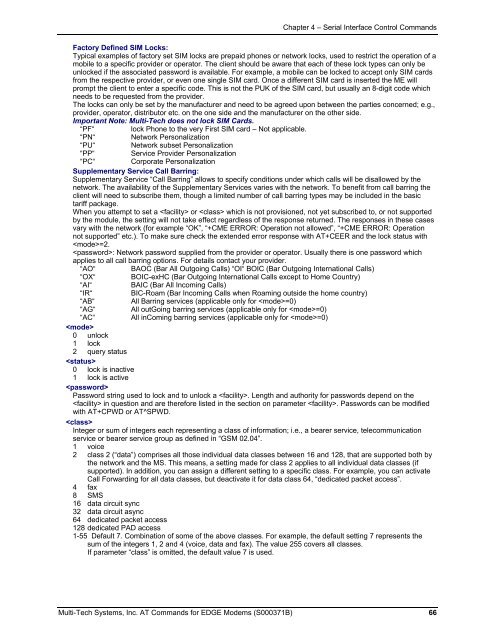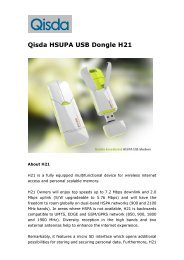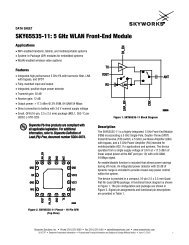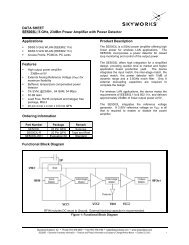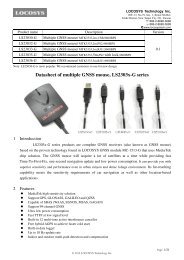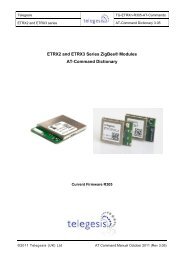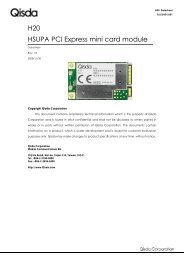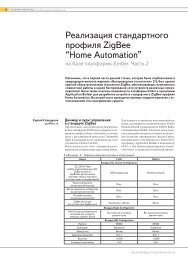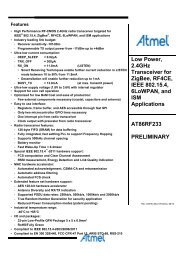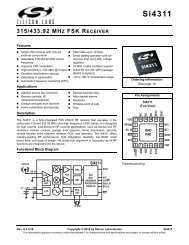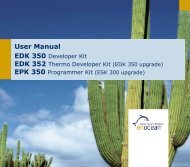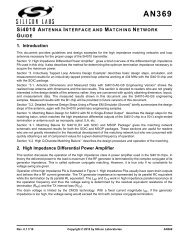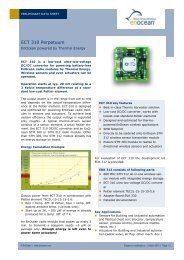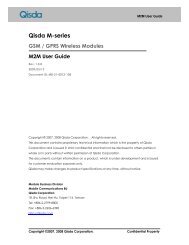AT Command Reference Guide for EDGE Wireless ... - wless.ru
AT Command Reference Guide for EDGE Wireless ... - wless.ru
AT Command Reference Guide for EDGE Wireless ... - wless.ru
Create successful ePaper yourself
Turn your PDF publications into a flip-book with our unique Google optimized e-Paper software.
Chapter 4 – Serial Interface Control <strong>Command</strong>s<br />
Factory Defined SIM Locks:<br />
Typical examples of factory set SIM locks are prepaid phones or network locks, used to restrict the operation of a<br />
mobile to a specific provider or operator. The client should be aware that each of these lock types can only be<br />
unlocked if the associated password is available. For example, a mobile can be locked to accept only SIM cards<br />
from the respective provider, or even one single SIM card. Once a different SIM card is inserted the ME will<br />
prompt the client to enter a specific code. This is not the PUK of the SIM card, but usually an 8-digit code which<br />
needs to be requested from the provider.<br />
The locks can only be set by the manufacturer and need to be agreed upon between the parties concerned; e.g.,<br />
provider, operator, distributor etc. on the one side and the manufacturer on the other side.<br />
Important Note: Multi-Tech does not lock SIM Cards.<br />
“PF“<br />
lock Phone to the very First SIM card – Not applicable.<br />
“PN“ Network Personalization<br />
“PU“ Network subset Personalization<br />
“PP“ Service Provider Personalization<br />
“PC“ Corporate Personalization<br />
Supplementary Service Call Barring:<br />
Supplementary Service “Call Barring” allows to specify conditions under which calls will be disallowed by the<br />
network. The availability of the Supplementary Services varies with the network. To benefit from call barring the<br />
client will need to subscribe them, though a limited number of call barring types may be included in the basic<br />
tariff package.<br />
When you attempt to set a or which is not provisioned, not yet subscribed to, or not supported<br />
by the module, the setting will not take effect regardless of the response returned. The responses in these cases<br />
vary with the network (<strong>for</strong> example “OK”, “+CME ERROR: Operation not allowed”, “+CME ERROR: Operation<br />
not supported” etc.). To make sure check the extended error response with <strong>AT</strong>+CEER and the lock status with<br />
=2.<br />
: Network password supplied from the provider or operator. Usually there is one password which<br />
applies to all call barring options. For details contact your provider.<br />
“AO“ BAOC (Bar All Outgoing Calls) “OI“ BOIC (Bar Outgoing International Calls)<br />
“OX“ BOIC-exHC (Bar Outgoing International Calls except to Home Country)<br />
“AI“<br />
BAIC (Bar All Incoming Calls)<br />
“IR“<br />
BIC-Roam (Bar Incoming Calls when Roaming outside the home country)<br />
“AB“ All Barring services (applicable only <strong>for</strong> =0)<br />
“AG“ All outGoing barring services (applicable only <strong>for</strong> =0)<br />
“AC“ All inComing barring services (applicable only <strong>for</strong> =0)<br />
<br />
0 unlock<br />
1 lock<br />
2 query status<br />
<br />
0 lock is inactive<br />
1 lock is active<br />
<br />
Password string used to lock and to unlock a . Length and authority <strong>for</strong> passwords depend on the<br />
in question and are there<strong>for</strong>e listed in the section on parameter . Passwords can be modified<br />
with <strong>AT</strong>+CPWD or <strong>AT</strong>^SPWD.<br />
<br />
Integer or sum of integers each representing a class of in<strong>for</strong>mation; i.e., a bearer service, telecommunication<br />
service or bearer service group as defined in “GSM 02.04”.<br />
1 voice<br />
2 class 2 (“data”) comprises all those individual data classes between 16 and 128, that are supported both by<br />
the network and the MS. This means, a setting made <strong>for</strong> class 2 applies to all individual data classes (if<br />
supported). In addition, you can assign a different setting to a specific class. For example, you can activate<br />
Call Forwarding <strong>for</strong> all data classes, but deactivate it <strong>for</strong> data class 64, “dedicated packet access”.<br />
4 fax<br />
8 SMS<br />
16 data circuit sync<br />
32 data circuit async<br />
64 dedicated packet access<br />
128 dedicated PAD access<br />
1-55 Default 7. Combination of some of the above classes. For example, the default setting 7 represents the<br />
sum of the integers 1, 2 and 4 (voice, data and fax). The value 255 covers all classes.<br />
If parameter “class” is omitted, the default value 7 is used.<br />
Multi-Tech Systems, Inc. <strong>AT</strong> <strong>Command</strong>s <strong>for</strong> <strong>EDGE</strong> Modems (S000371B) 66


